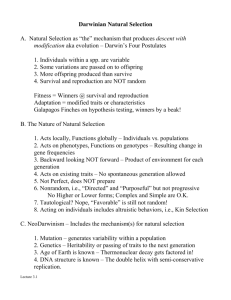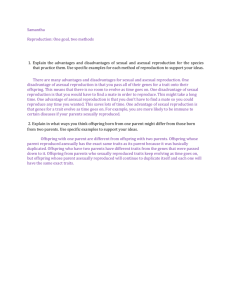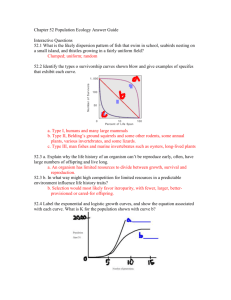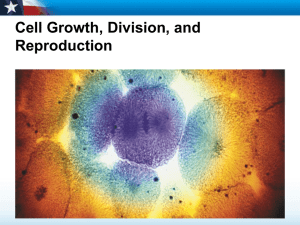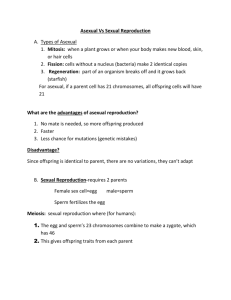Lecture 8: Life History Patterns Dafeng Hui Office: Harned Hall 320
advertisement
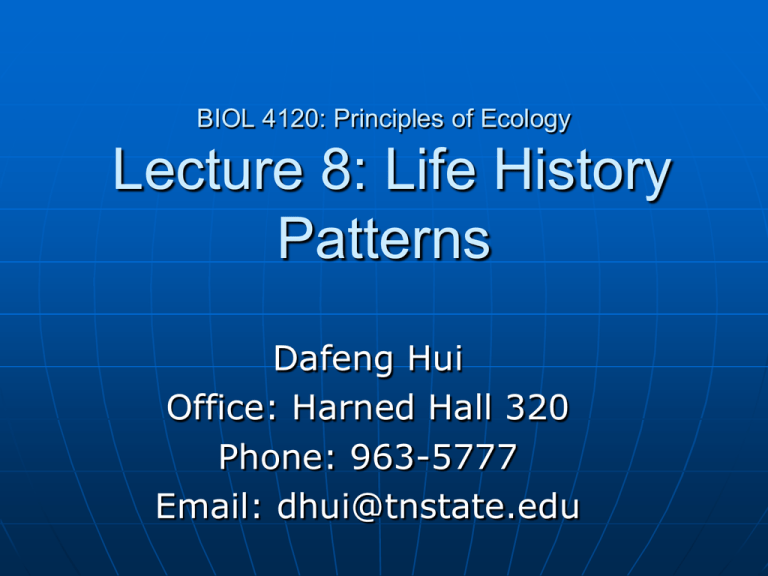
BIOL 4120: Principles of Ecology Lecture 8: Life History Patterns Dafeng Hui Office: Harned Hall 320 Phone: 963-5777 Email: dhui@tnstate.edu Life History Life history is species lifetime pattern of growth, development and reproduction. Measure of organism’s reproductive success is fitness: Those individuals who leave the largest number of mature offspring are the most fit the environments. Trade-off between growth and reproduction: mode of reproduction, age at rep., allocation to rep. number and size of eggs, young or seeds, parental care. Life History Patterns 8.1 Reproduction may be sexual or asexual 8.2 Sexual reproduction takes a variety of forms 8.3 Mating systems 8.4 Mate selection 8.5 Females may acquire mates based on resources 8.6 Organisms budget time and energy to reproduction 8.7 Species differ in the timing of reproduction 8.8 Parental investment 8.9 Fecundity depends on age and size 8.10 Food supply affects the production of young 8.11 Reproductive effort may vary with latitude 8.12 Habitat selection influences reproduction success 8.13 Environmental conditions influence the evolution of life history characteristics 8.1 Sexual or Asexual Reproduction Asexual reproduction (produce offspring without involving of egg and sperm) • • • • • • New individuals are the same as the parent Many plants (underground stem) such as strawberry; some animals (hydra, some aphids, parthenogenesis) If fitness is high, matches organism to environment If fitness is low, possible extinction (less variation) Stress can result in use of sexual cycle to give new gene combinations (hydra, aphid) Sexual Reproduction • More common form. • Can produce new gene combinations able to cope with a changing environment. • Greater energy commitment Specific organelles Production of gametes, courtship activities, and mating are energetically expensive. Feeding offspring The expense of reproduction is not shared equally by both sexes 8.2 Types of sexual reproduction Dioecious • Sexes are separate individuals • Greatest diversity of offspring Hermaphroditic • Perfect Male and females organs in same flower Can result in significant inbreeding • Monoecious Floral structure Plants Separate male and female flowers Reduces but does not eliminate inbreeding Animals Most familiar form involves male and female individuals Hermaphroditic • Simultaneous hermaphroditic Both sets of organs at same time • Earthworms • Outbreeding, but maximizes offspring (twice) • Sequential hermaphroditic First one sex then the other sex • Mollusks, echinoderms Sometimes animals (fish) • Allows all individual to participate in both sides of sexual cycle Plant can undergo sex change: jack-inthe-pulpit (Arisaema triphyllum) Parrotfish Largest female will become male when the male fish is missing 8.3 Mating Systems describe pairing of males and females Different mating strategies have different advantages and disadvantages • Monogamy (one to one, form of a lasting pair bond between one male and one female) Most prevalent among birds, rare among mammals Seasonal or permanent • Allows sharing of cost of raising offspring • Increases survival chances of offspring • Cheating does occur and has specific advantages to fitness • Polygamy (one to two or more, a pair bond exists between individual and each mate) More than one mate of one sex for a single individual of the other sex (polygyny and polyandry) • Free individual to compete for resources and protect territory • Better food etc for mates • Some protection of offspring from competition • Promiscuity (one to one or many and no pair bound formed) Greatest number of offspring Large amount of competition Female only responsible for offspring in terms of resources • Poorer survival chance for offspring 8.4 Sexual Selection For Monogamy, Polygamy and Promiscuity • All involve the selection of a mate and therefore sexual selection • Selection for secondary sexual characteristics Peacock versus Peahen • Large tail feathers, more mating • Smaller tail feathers, less mating Deer • Characters that aid competition such as horns Humans • Faster sports car such as a Ferrari Sexual selection Intrasexual selection • male-to-male competition for the opportunity to mate • exaggerated secondary sexual characteristics such as large size, aggressiveness and organs of threat such as antler and horns Intersexual selection • Differential attractiveness of individuals of one sex to another • Characteristics in male such as bright or elaborate plumage used in sexual display as well as these in intrasexual selection. What is the mate really looking for in sexual selection In most cases the sexually selected characteristic is an indirect measure of resources or fitness • Bigger males have captured more resources (large territories, abundance of food etc) Sports car • Is this just a display Big red car that makes a lot of noise • Or does it measure resources Ferraris are expensive 8.5 Organisms budget time and energy to reproduction Reproductive effort: Time and energy allocated to reproduction Trade-off between growth, maintenance and reproduction. • There is a negative relationship between annual plant growths and the allocation to reproduction. Percentage of annual production to reproduction: Perennials: 15-20% Wild annuals: 15-30% Crops: 25-30% Corn and barley: 35-40% Lizard: 7-9% Salamander: 48% Species’ trait Production of offspring Costs of care and nourishment Bird species (dots) illustrate the tradeoff between “fast” organisms (high fecundity, high mortality) versus “slow” ones (long life, low annual fecundity) Species differ in timing of reproduction Semelparity • One reproductive effort with all resources, then death • Most insects and other invertebrates, some fish (salmon) and many plants (bamboo, ragweed) • Some are small, short lived, grown in disturbed habitats; • Environmental effect can be disastrous Iteroparity • Produce fewer young at one time and repeat reproduction throughout their lifetime • Multiple cycles of reproduction means the organism must balance growth, maintenance, escaping predators, defending territory, etc against reproduction • Most vertebrates, perennial herbaceous plants, shrubs, and trees. Timing production: When – early or late How many offspring: cost of the fecundity and its own survival. Sockeye salmon, for example, swim as far as 6,000 km from Pacific Ocean feeding grounds to spawning streams, lay thousands of eggs, then die from the exertion. 8.6 Parental investment depends on the number and size of offspring Given certain resource allocated to rep., one can produce many small young or few large ones. The number of offspring affects parental investment. Produce large number of offspring, less or no parental care (fish-eggs, plants-seeds) Produce helpless offspring (produce young, spend less energy in incubation, but require considerable parental care) • Altricial • Mice Longer period suckling • Robin Other bird feeds Produce more mature offspring (longer gestation, born in advantaged stage of development) • Precocial • Chicken, cow, deer, turkey Humans ? Family care (Grandmothers, Grandfathers, Aunts, Uncles, Brothers and Sisters) African elephants produce one offspring at a time, once every few years over a long lifetime, and protect each offspring intensively (much like humans) Few Number • More resources per individual • More chance of accidental loss By contrast, many plants and some insects, reproduce once (annually), producing vast numbers of seeds/eggs that are poorly protected, if at all Large Number Less resources per individual More chances of success Desert annuals Extreme with released eggs of some fish such as cod (millions of eggs) etc 8.7 Fecundity depends on age and size For many species, number of offspring produced varies with the age and size of parent. But some species do not have a characteristic adult size and can continue to grow through their adults lives (indeterminate growth) • Many plants and ectothermic (cold-blooded) animals (fish, reptiles, amphibians, and invertebrates) Plants Perennial: delay flowering until they have attained a sufficiently large size Biennial: delay flowering beyond 2-yr life span under poor environments Annual: small plants produce less seeds Animals: Ectothermic (cold-blooded) animals Production of offspring in fish increases with size, which increases with age Gizzard shad: 2-yr, 59,000 eggs 3-yr, 379,000 eggs Endothermic (warm-blooded): similar patterns exist for some animals European red squirrel: body weight and reproduction success; <300 g, do not reproduce. 8.8 Reproduction effort may vary with latitude Birds in temperate regions have a larger clutch size than tropical birds • Food supply, with longer day length in springtime to forage for food to support larger broods • large climate variation, decreases popul. below carrying capacity, need more young • Greater mortality in winter results in more food for survivors next spring Habitat Selection Neotropical warblers Process in which organisms actively choose a specific location is called habitat selection. Filling the available niches (enough food, water etc) and keeping out competitors (find neighbors), may settle in less ideal habitats Exception humans • All habitats • Left Africa and adapted the environment rather than adapted to the environment 8.9 Environmental conditions influence the evolution of life history characteristics Idea was conceived by Robert MacArthur and Edward O. Wilson: “rvs. K-selected strategists” Derivation of the terminology comes from population models (see future lecture): • “r” is population growth rate; rselected species have traits that increase r • “K” is population carrying capacity; K-selected species have traits that increase carrying capacity and competitive ability when populations fill environment Spotted and redback salamanders Examples of r- and K-selected organisms r-selected organisms—short-lived, e.g., dandelion, with rapid population growth rate, small body size, early maturity, larger number of offspring, minimal parental care (animals). Inhabit unstable conditions, disturbed areas. K-selected organisms –competitive species, long-lived, e.g., oak tree with long life, production of few, large seeds that can grow readily in shaded environments, but lack of mean of wide dispersal, poor colonizers of new or empty habitats. Summary of life-history traits in r-selected versus K-selected strategists “strategy” 1. Environment 2. Mortality 3. Population size 4. Competition? 5. Favored traits r-strategist K-strategist variable constant, predictable density independent. dens.-dep. variable, below K constant, at K variable, lax keen rapid development (opposites) early reproduction small body size semelparity short generation time good dispersal, colonizing ability high allocation to reproduction (small offspring/seed sizes; many offspring) The End Reproduction effort may vary with latitude Set nest boxes at two places Illinois Panama Monitor and collect newly laid eggs over one breeding season Eggs are marked by date and weighted Hatched in incubators at 37.8~38oC, RH 85-90% Another interesting thing is that it takes the same amount of time to hatch in nature and incubators (for current setting) Conclusions: Ecologists have made great progress explaining many (but by no means all) life history traits, using arguments based on individual level natural selection Life-history traits are often correlated in their distribution because of the effect of habitats on multiple traits Tradeoffs among different traits are also very common, indicating the inability to evolve one phenotype that is perfect in all situations: Organisms have been selected to allocate resources differentially in different environments Ruderal Small and rapid lifecycle to invade new sites. Large dispersal area Competitive Stable environment, slower lifecycle With more resources to growth Stress-tolerant Limited resources. Ability to adapt



